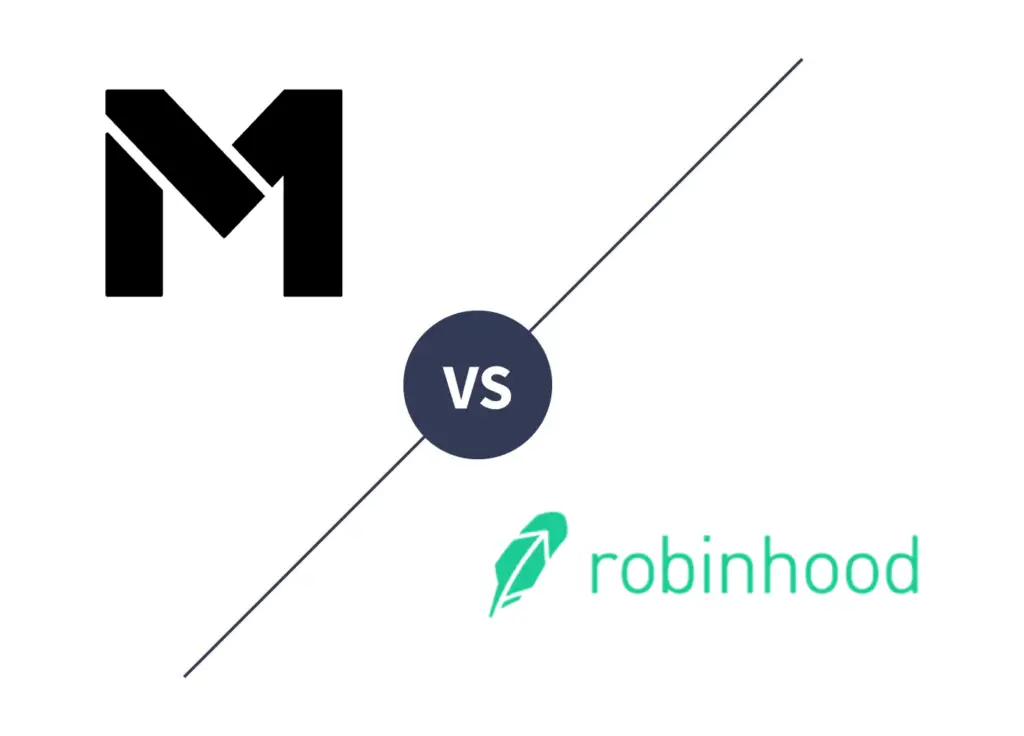
M1 Finance and Robinhood have emerged as two of the most popular platforms for fee-free investing. Here we'll compare them. I wrote a separate comprehensive review of M1 Finance here if you're interested in reading about the nuances of the platform.
Disclosure: Some of the links on this page are referral links. At no additional cost to you, if you choose to make a purchase or sign up for a service after clicking through those links, I may receive a small commission. This allows me to continue producing high-quality content on this site and pays for the occasional cup of coffee. I have first-hand experience with every product or service I recommend, and I recommend them because I genuinely believe they are useful, not because of the commission I may get. Read more here.
M1 Finance vs. Robinhood – Summary Comparison
Contents
M1 Finance vs. Robinhood – Commissions and Fees
Both M1 Finance and Robinhood offer fee-free investing. No trade commissions, no account fees. There are obviously miscellaneous one-time fees for things like paper statements, outbound account transfers, etc.
M1 Finance does offer a premium membership called M1 Plus for $125/year that gets you a cheaper margin rate and a second trading window if you want.
Robinhood has a premium option called Robinhood Gold that costs $5/mo. ($60/year) and gets you access to professional research reports, deeper market data, margin, and instant deposits.
M1 Finance vs. Robinhood – Account Types
M1 Finance offers the following account types:
- Taxable
- Joint
- Traditional IRA
- Roth IRA
- Rollover IRA
- SEP IRA
- Trust
- Custodial (M1 Plus members)
Robinhood only offers a standard taxable account at this time. They do not offer retirement, joint, trust, or custodial accounts. They state that they hope to in the future.
Neither platform offers the following:
- SIMPLE IRA
- Solo 401(k)
- 529
- HSA
- Non-Profit
M1 Finance vs. Robinhood – Investment Products
M1 Finance offers most ETF's and individual stocks that are traded on major exchanges.
Robinhood also offers stocks and ETF's, plus options and crypto trading.
M1 Finance vs. Robinhood – Customer Service
I've personally never had any issues with the customer service of M1 Finance. I have seen some anecdotes complaining of them being somewhat slow. I'd like to think M1 is working on improving that.
Robinhood has somewhat of a reputation for being slow or unresponsive at times with their customer service, and famously doesn't have a published phone number.
Robinhood Outage and Other Issues
More importantly, Robinhood experienced outages on 3 days within a single week in early March 2020, which they chalked up to “stress on our infrastructure—which struggled with unprecedented load.” One of those outages lasted an entire trading day. Needless to say, this was extremely frustrating and concerning for customers, especially since these were extremely high-volume days in the market.
Following the debacle, Robinhood users have since filed a class-action lawsuit against the trading platform, alleging that “Robinhood had a duty to provide a system and platform ‘robust enough' to handle that trading volume and have a backup system to handle outages.”
In December 2020, the SEC fined Robinhood $65 million for misleading users about its selling of order flow between 2015 and 2018, meaning users got worse trade execution prices than the platform claimed. Robinhood maintains that these were “historical practices that do not reflect Robinhood today.”
In the same week, the Massachusetts Securities Division filed a lawsuit against Robinhood, alleging that the broker uses “gaming strategies to manipulate customers” to execute more trades in order to boost fees, thereby taking advantage of inexperienced investors.
There are also plenty of user complaints such as these of the site being “frozen,” orders not going through, inability to login, etc.
On the one hand, one could argue that these learning experiences will cause Robinhood to make sure these types of things never happen again in the future. On the other hand, it is disconcerting regarding the future of the platform considering other brokers didn't experience these outages and problems. I've already seen many users running from Robinhood in droves and finding alternatives in platforms like M1 Finance, TD Ameritrade, Schwab, and Webull. It will be interesting to see how the future plays out for the platform.
Perhaps most importantly, Robinhood users have been fleeing en masse after the broker's recent stance on temporarily blocking users from buying stocks like GameStop ($GME) and AMC Entertainment ($AMC) during the massive short squeeze event. As of February 1, 2021, over 33 federal lawsuits have been filed against the platform across the country, citing securities trading and consumer protection violations, which add insult to injury after Robinhood hid the fact that it sold order flow and gave users worse trade execution prices.
The name of the platform now seems ironic, considering Robinhood seems to be placating hedge funds and Wall Street hotshots – at the expense of retail investors – at every turn.
On June 30, 2021, FINRA fined Robinhood $70 million for “systematic supervisory failures.”
M1 Finance vs. Robinhood – Margin
Margin is simply a collateralized loan on your invested securities to provide enhanced exposure for investing or trading.
With Robinhood, in order to access margin, you must pay for the $5/mo. Margin Gold premium account and have a minimum balance of $2,000.
To access margin on M1 Finance, you need a taxable account of at least $10,000.
Here's how the margin rates stack up between M1 Finance and Robinhood:
- M1 Finance: 3.50%
- M1 Plus: 2.00%
- Robinhood: 5.00%
M1 Plus is a $125/year premium membership that gets you access to a 1.5% lower margin rate as shown, and a second trading window.
The margin loan from M1 Finance can be used for whatever you want – refinancing higher-interest debt, major purchases, unexpected expenses, etc.; it's just a low-interest collateralized loan.
Remember that margin is an additional risk, including the risk of losing more than you invest. Margin is not available for retirement or custodial accounts. Rates may vary.
M1 Finance vs. Robinhood – Mobile App
M1 Finance has a sleek, modern, intuitive mobile app for Apple iOS and Android. Robinhood seems to have a good, comparable app for Apple iOS, but Android users have complained that the Robinhood app is problematic and unsupported.
Here are some screenshots of the M1 app:
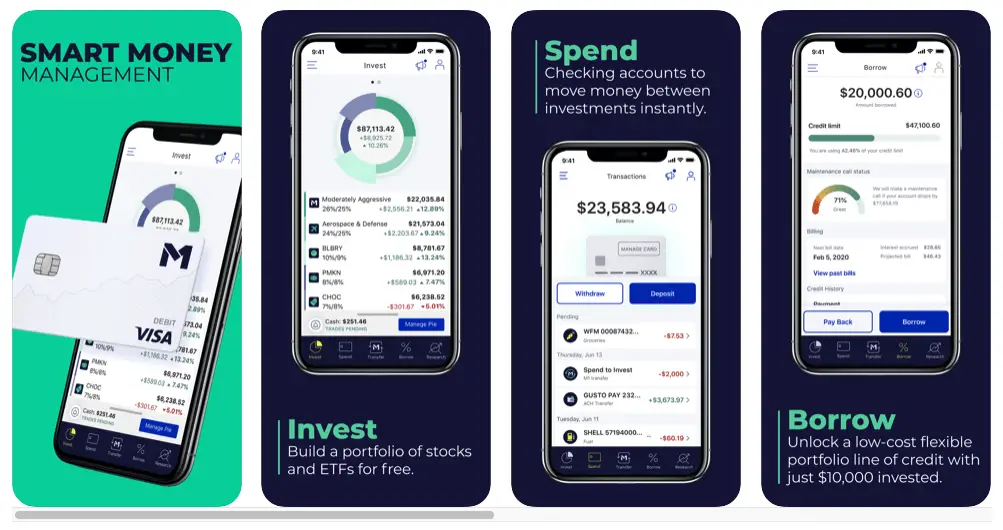
Here are some screenshots of the Robinhood mobile app:
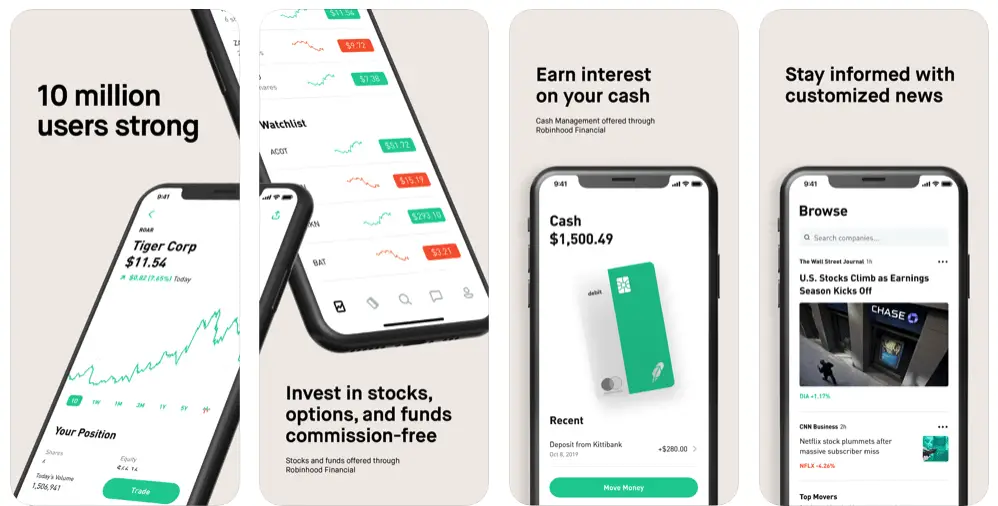
M1 Finance vs. Robinhood – Interface/Usability
M1 Finance has a very intuitive, simple interface that is easy for beginner and seasoned investors.
Robinhood has a bit more technical analysis and research tools, and as such has a slightly less intuitive interface, but not by much.
Here's M1 with its pie-based visualization:
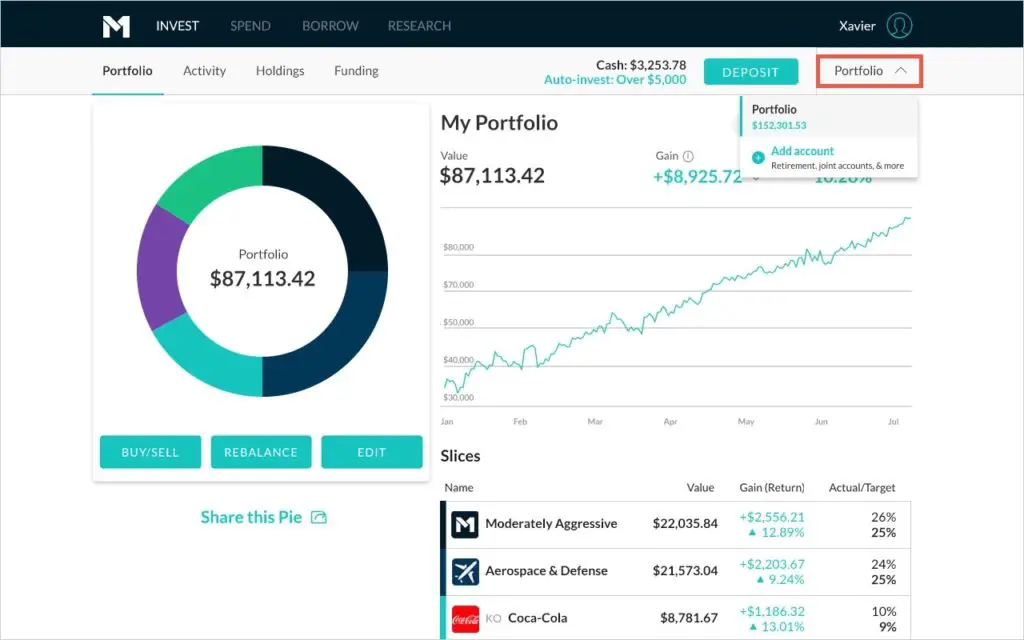
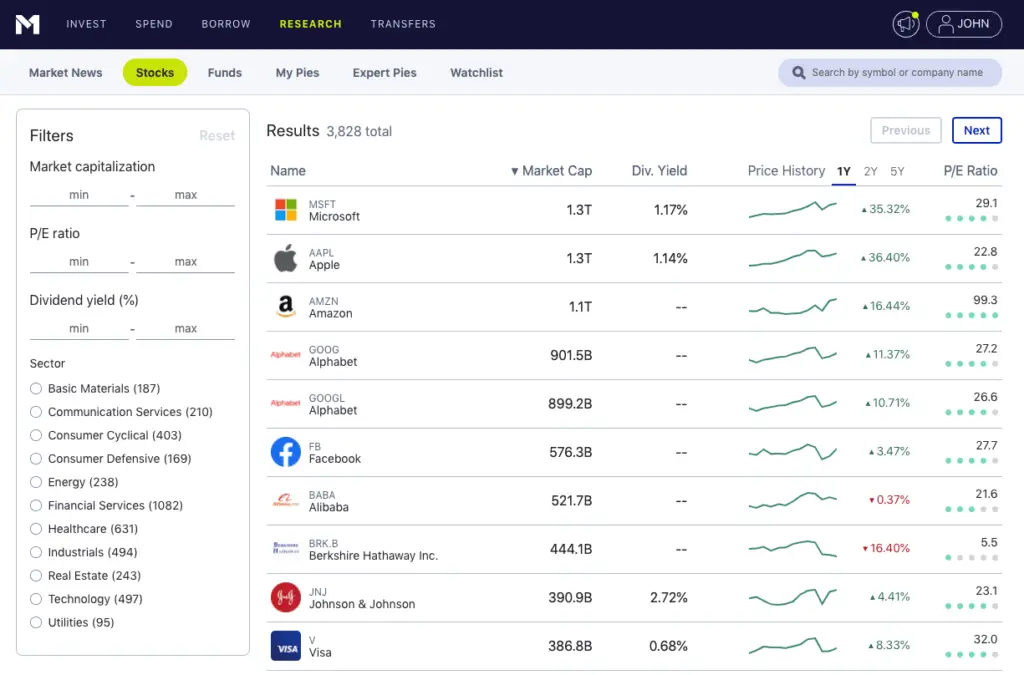
And here's Robinhood:
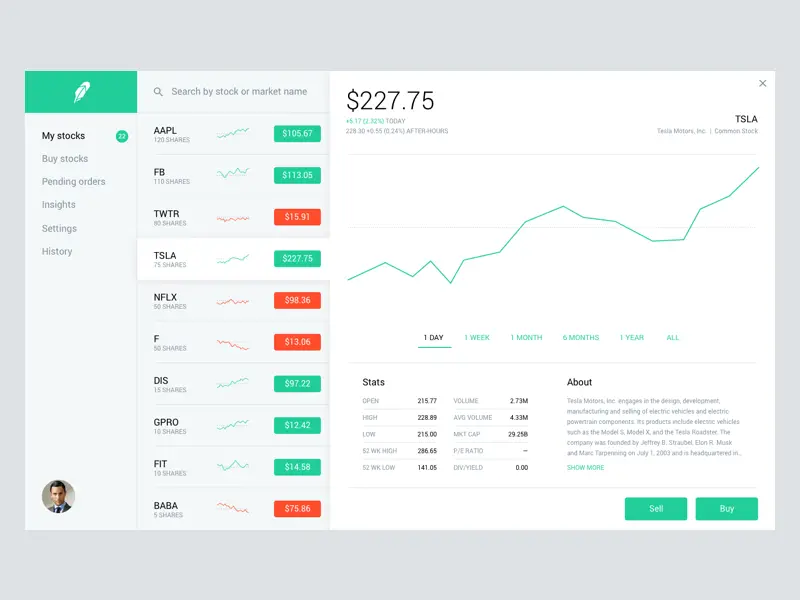
M1 Finance vs. Robinhood – Extra Features
Both M1 Finance and Robinhood offer an optional FDIC-insured checking account with debit card, making them a collection of financial tools rather than just investing platforms. At the time of writing, with their premium M1 Plus option, you can earn 1% APY and 1% cash back on that checking account. Robinhood offers 0.30% APY and no cash back.
M1 Finance features “dynamic rebalancing,” using new deposits to automatically rebalance your portfolio to its target asset allocation, and fractional shares, a feature that allows every penny to work for you. Robinhood also offers fractional shares but no automatic rebalancing.
As a full-fledged trading platform, Robinhood obviously offers an all-day trading window and order control. M1 Finance, on the other hand, being built for long-term buy-and-hold investing, has one daily trading window in the morning and no advanced order control. Their premium M1 Plus membership gets you access to a second afternoon trading window.
In terms of user education, Robinhood's articles will be a little more technical in nature. Both platforms have a blog where they post useful tips and guides.
M1 Finance vs. Robinhood – Summary and Conclusion
- M1 Finance and Robinhood are both commission-free investing platforms.
- M1 Finance offers more account types than Robinhood. Robinhood only offers an individual taxable account and no retirement, joint, or trust accounts.
- M1 Finance offers most ETF's and individual stocks. Robinhood offers the same, plus options contracts and cryptocurrency.
- Robinhood's customer service and overall stability seem very questionable.
- M1's margin rates are lower than those of Robinhood. Robinhood charges $5/mo. to access a margin account.
- M1 Finance has a solid mobile app for both Apple iOS and Android. Robinhood's Android app is lacking.
- Both M1 Finance and Robinhood offer an optional FDIC-insured checking account.
- Both M1 Finance and Robinhood offer fractional shares, but only M1 offers automatic rebalancing.
- M1 is probably better if you want to implement a “lazy portfolio” and have it rebalance automatically.
- Robinhood has an all-day trading window and order control, and is thus better suited for traders. M1 has a once-per-day trading window and no order control.
M1 Finance is great for both beginner and seasoned long-term investors who want full portfolio control, zero fees, and access to cheap margin. Unlike Robinhood, M1 is not designed for – and would be a poor choice for – day traders. M1 has a more intuitive interface and is better suited for beginner investors. Compared to Robinhood, it offers more account types and automatic rebalancing, and is thus better for long-term buy-and-hold investing.
Robinhood, offering all-day trading and order control, is the better choice for traders. The platform does not offer retirement accounts. Like M1, Robinhood uses fractional shares and has an optional checking account. Robinhood's margin is more expensive than M1's. Perhaps most importantly, the customer service and overall stability of Robinhood seem questionable, given the widespread user complaints and pending lawsuit over its March 2020 outages. I would suggest considering Webull as an alternative to Robinhood if you want to day-trade stocks but don't need fractional shares.
I wrote a separate comprehensive review of M1 Finance here if you're interested in seeing the nuances of the platform.
Right now M1 is offering a transfer promotion of a 0.50% payout on settled transfers over $10,000 into Invest accounts before January 31 with a max payout of $25,000. Terms for this promotion are here.
Disclaimer: While I love diving into investing-related data and playing around with backtests, this is not financial advice, investing advice, or tax advice. The information on this website is for informational, educational, and entertainment purposes only. Investment products discussed (ETFs, mutual funds, etc.) are for illustrative purposes only. It is not a research report. It is not a recommendation to buy, sell, or otherwise transact in any of the products mentioned. I always attempt to ensure the accuracy of information presented but that accuracy cannot be guaranteed. Do your own due diligence. I mention M1 Finance a lot around here. M1 does not provide investment advice, and this is not an offer or solicitation of an offer, or advice to buy or sell any security, and you are encouraged to consult your personal investment, legal, and tax advisors. Hypothetical examples used, such as historical backtests, do not reflect any specific investments, are for illustrative purposes only, and should not be considered an offer to buy or sell any products. All investing involves risk, including the risk of losing the money you invest. Past performance does not guarantee future results. Opinions are my own and do not represent those of other parties mentioned. Read my lengthier disclaimer here.

Are you nearing or in retirement? Use my link here to get a free holistic financial plan and to take advantage of 25% exclusive savings on financial planning and wealth management services from fiduciary advisors at Retirable to manage your savings, spend smarter, and navigate key decisions.

Leave a Reply